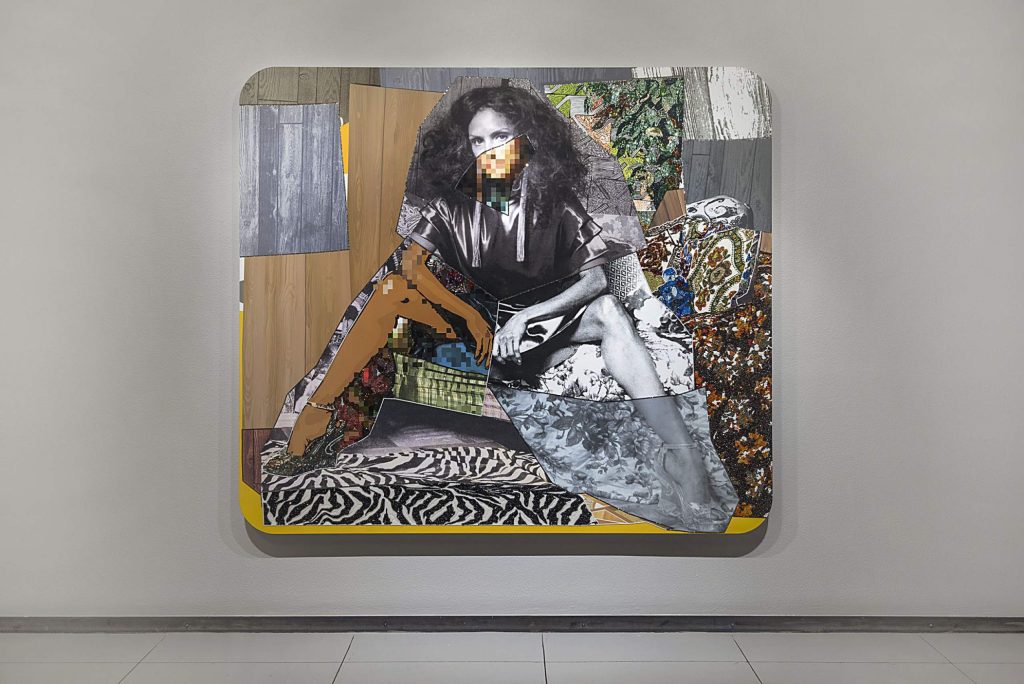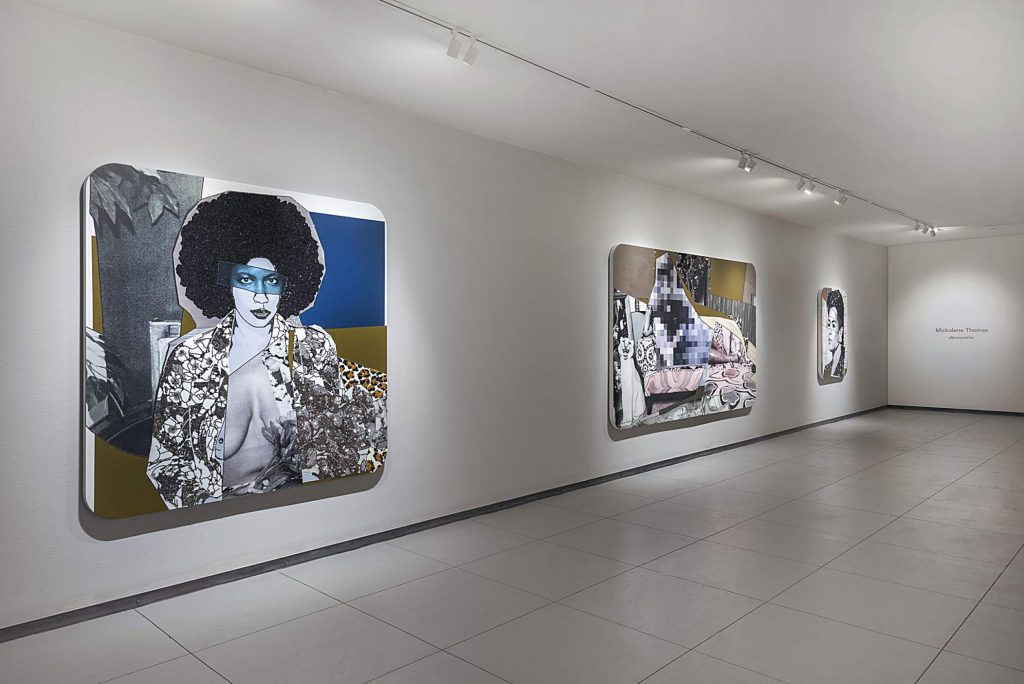Review: Mickalene Thomas’s ‘découverte’ at Baldwin Gallery in Aspen
Special to The Aspen Times
IF YOU GO …
What: Mickalene Thomas, “découverte”
Where: Baldwin Gallery
When: Through Feb. 7
More info: baldwingallery.com
The artist Mickalene Thomas has returned to Aspen this winter with a show of current work at the Baldwin Gallery that opened Dec. 26. The town’s art crowd will remember her exhibition at the Aspen Art Museum in the summer of 2016. The museum accommodated the various media of Thomas’s ambitious practice — video, installation and wall pieces. For this show at Baldwin, her Brooklyn studio has shipped out six large, mixed-media paintings, all produced in 2019. In these works Thomas carries on with her long-term project of portraying the women in her life, including her partner, Racquel Chevremont. It’s familiar Thomas territory, though this latest iteration deserves an updated reading.
Thomas was born in 1971 and grew up in Camden, New Jersey. Her mother, the sometime model Sandra Bush, planted in the young Mickalene a consciousness of art by enrolling her in after-school museum programs in and around Newark. In the standard online biographies, a father is conspicuous in his absence. When ready for college, Thomas moved to Portland, Oregon, where she intended to study law. But the city’s burgeoning arts scene tugged at her. Her conversion moment came when a friend took her to see photographs of black women and their families by the artist Carrie Mae Weems.
Thomas returned to the East to attend art school, first at the Pratt Institute and then the MFA program at Yale, one of country’s most esteemed studio art departments. As she reached the end of her formal education, Thomas took the advice of a teacher to make a series of photographic portraits of a difficult subject. Her mother was the obvious choice. Thomas had been estranged from her after a home life marred by drug addiction. But she recognized in Sandra Bush an archetype of black femininity which she did not see in the white cultural landscape. From that foundational study of her mother, Thomas expanded her scope to other black women, some friends, some lovers, some celebrities. As Thomas worked through the challenge of representing race, sexuality and gender, she did so with a keen sensitivity for traditional portraiture and the nude woman in art history. She carries on an audible dialogue with masters of the Western tradition: Titian, Goya, Ingres, Courbet, Manet and even 20th-century modernists such as Picasso whose cubism dismantled the female form.
Thomas is not alone in her concern for the relative absence of the black subject in fine art and for its objectification when it does appear. Along with Weems, artists such as David Hammons, Amy Sherald, Kerry James Marshall, Barkley Hendricks, Kehinde Wiley and Emma Amos have attempted to fill this gap. Among these African American contemporaries, Thomas is unique in her concentration on the female figure, who is often stretched out on a chaise in the classical, atelier pose and often partially nude. The typical Thomas sitter challenges the viewer with a direct, unsmiling gaze, in an assertion of her right to occupy the space of high culture alongside the white Venuses and odalisques and courtesans of academic painting. The women of the Baldwin show are likewise self-assured and at ease with the intimate portrayal of both their psychological state and sexual physicality.
Two decades into her own career, Thomas is now leveraging her success to advance the art of young women of color. She and Chevremont, working under the banner of Deux Femmes Noires, mentor artists and curate exhibitions that bring underrepresented work into greater visibility. The social and the political continue to permeate Thomas’ studio production, as well. The originary mission of giving an appropriate place to the black female body in visual culture remains needful and compelling.
As much as this agenda continues to motivate Thomas, the works themselves, including the Baldwin paintings, have always been generous, inviting, open-handed, celebratory. Thomas welcomes the viewer in sharing in the excitement that she feels for her subjects. She allows herself, and by extension the viewer, to indulge in a bit of naughty-girl erotic fun. There also is an element of humor in these stagings. She prevents the confidence of her sitters from coming off as confrontational or militant by couching them in a riot of patterned textiles and sparkles. As present and direct as the sitters are, her interiors are playful caricatures of what one imagines were the living rooms, bedrooms and dens of Thomas’ youth. If the people appear dead serious, the rhinestones and floral patterns and fake fur prints leaven the mood. These elements, meticulously crafted, encourage an experience of aesthetic pleasure that is not separate from the social/political mission but are its positive expression.
In the arc of Thomas’ evolution, now spanning 20 years, she has increasingly denatured the subject, moving past photographic documentation into more abstracting modes of figuration. The areas of concern that were so forward in the earlier work are in the current paintings partially occluded by non-objective painted and mixed-media elements. This masking of the parts of the figure indicates the possibility — not yet fully realized — of an important shift. When Thomas chooses to cover parts of the sitter’s body with a grid of colors (these grids do not read as pixelation, even if that was her intention), or to surgically excise eyes and replace them with a drawing, it is to dilute the specificity of that individual and indicate the possibility of other traits, physical or otherwise. In the most hopeful understanding of these interventions, I want to think that Thomas is suggesting the constituent elements of a complete individual include but go beyond the trinity of race, sexuality and gender. Portraiture in its most programmatic, ideological mode, seeks to endow qualities on the subject which are valued at that moment. A pope wants to project ecclesiastical authority; the saint a spiritual purity; the statesman public integrity; the general military prowess. It is with Velásquez that portraiture begins to represent not just an overlay of virtues, but of persons fully individuated and possessed of complex personalities. In a seemingly paradoxical movement, Thomas could be pushing toward a more complete, three-dimensional notion of herself and her subject by being less prescriptive in how we should see them.
The success of the sole painting in the show that is not a portrait, her “Interior: Blue Couch with Chair and Flowers,” confirms the power of this nascent ambiguity. Besides showcasing Thomas’ masterful use of collage across a huge, complex composition, and her ability to evoke a particular kind of domestic interior, the absence of a figure creates the possibility that any anyone — a grandmother, a child, a neighbor — could come tripping into the picture and sit down on the couch. In this case, in one of the show’s paintings, Thomas allows the viewer to populate the scene however they like.
As a group, these paintings deliver a lot what dealers like to call “wall-power.” They are big, bold, verging on brash, and finely made, from the placement of rhinestones to the construction of the canvas/wood substrate. Their scale and execution, as well as the rest of Thomas’s extracurricular activities, bespeak a production capacity in her Brooklyn studio that must involve a lot of people. Thomas, in accordance with the standards of success in the contemporary art world, is not only an artist; she is a brand, an entity in the Art-Industrial Complex. It is indicative of her reach that Thomas came to Aspen in December not just for the opening of the Baldwin show but also to appear as guest of honor at a launch party for a limited-edition handbag that she designed for Dior. It’s the kind of thing art stars do and have done for a long time, and it doesn’t denote a compromise or a lessening of her seriousness of purpose.
Nonetheless, I come away from this show thinking that it has to be hard to manage everything that she does and still find the creative energy in the studio to extend herself beyond these successful but familiar pictorial recipes. She has positioned herself to be influential and innovative in any number of arenas, and so will have to decide going forward what priority to give to art-making.













